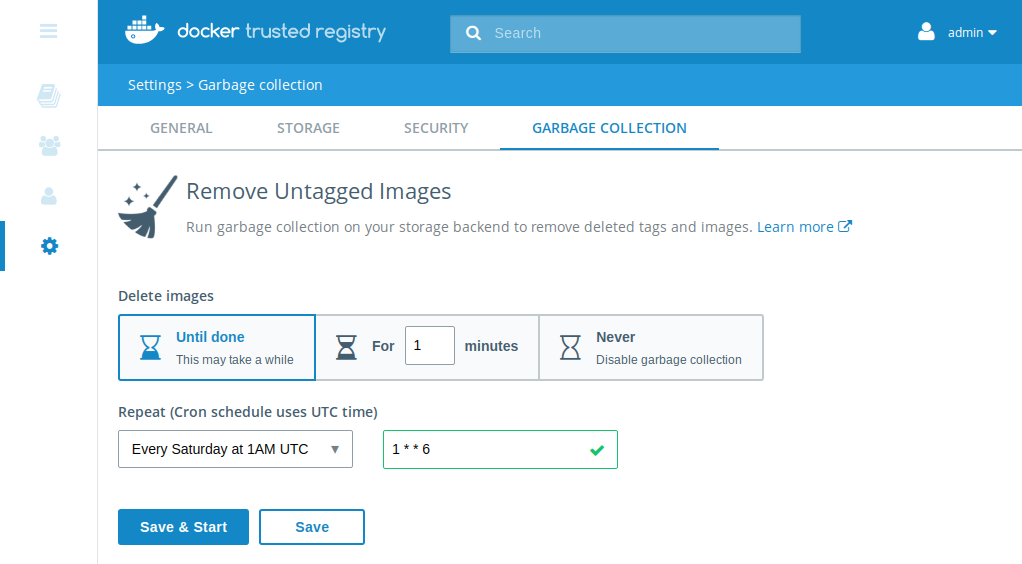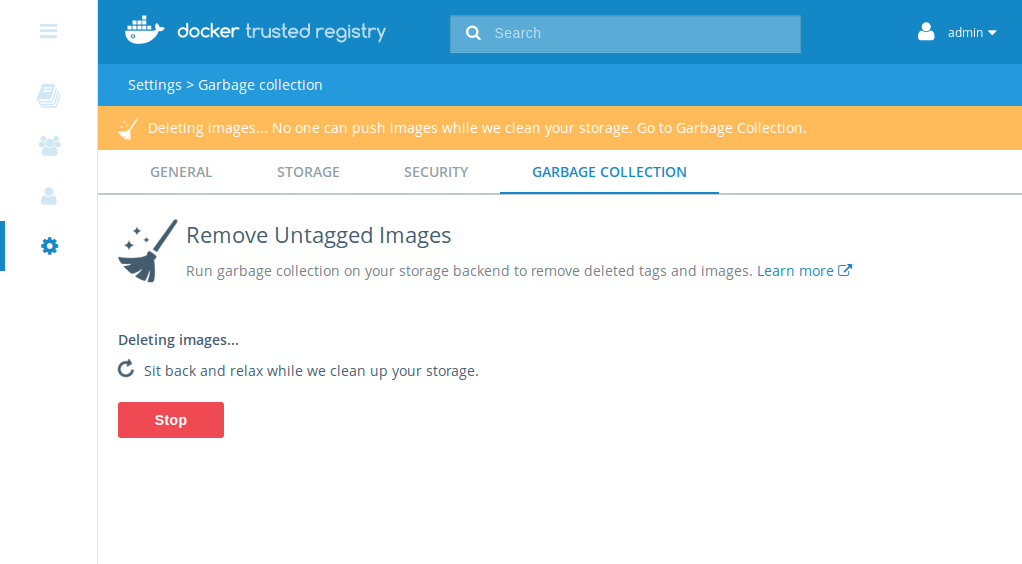Docker Trusted Registry 2.2 Garbage Collection
Estimated reading time: 3 minutesTL;DR
- Garbage Collection (GC) reclaims disk space from your storage by deleting unused layers
- GC can be configured to run automatically with a cron schedule, and can also be run manually. Only admins can configure these
- When GC runs DTR will be placed in read-only mode. Pulls will work but pushes will fail
- The UI will show when GC is running, and an admin can stop GC within the UI
Important notes
The GC cron schedule is set to run in UTC time. Containers typically run in UTC time (unless the system time is mounted), therefore remember that the cron schedule will run based on UTC time when configuring.
GC puts DTR into read-only mode; pulls succeed while pushes fail. Pushing an image while GC runs may lead to undefined behavior and data loss, therefore this is disabled for safety. For this reason, it’s generally best practice to ensure GC runs in the early morning on a Saturday or Sunday night.
Setting up garbage collection
You can set up GC if you’re an admin by hitting “Settings” in the UI then choosing “Garbage Collection”. By default, GC will be disabled, showing this screen:

Here you can configure GC to run until it’s done or with a timeout. The timeout ensures that your registry will be in read-only mode for a maximum amount of time.
Select an option (either “Until done” or “For N minutes”) and you have the option to configure GC to run via a cron job, with several default crons provided:

You can also choose “Do not repeat” to disable the cron schedule entirely.
Once the cron schedule has been configured (or disabled), you have the option to the schedule (“Save”) or save the schedule and start GC immediately (“Save & Start”).
Stopping GC while it’s running
When GC runs the garbage collection, the settings page looks as follows:

Note the global banner visible to all users, ensuring everyone knows that GC is running.
An admin can stop the current GC process by hitting “Stop”. This safely shuts down the running GC job and moves the registry into read-write mode, ensuring pushes work as expected.
How does garbage collection work?
Background: how images are stored
Each image stored in DTR is made up of multiple files:
- A list of “layers”, which represent the image’s filesystem
- The “config” file, which dictates the OS, architecture, and other image metadata
- The “manifest”, which is pulled first and lists all layers and the config file for the image.
All of these files are stored in a content-addressable manner. We take the
sha256 hash of the file’s content and use the hash as the filename. This means
that if tag example.com/user/blog:1.11.0 and example.com/user/blog:latest
use the same layers we only store them once.
How this impacts GC
Let’s continue from the above example, where example.com/user/blog:latest and
example.com/user/blog:1.11.0 point to the same image and use the same layers.
If we delete example.com/user/blog:latest but not
example.com/user/blog:1.11.0 we expect that example.com/user/blog:1.11.0
can still be pulled.
This means that we can’t delete layers when tags or manifests are deleted. Instead, we need to pause writing and take reference counts to see how many times a file is used. If the file is never used only then is it safe to delete.
This is the basis of our “mark and sweep” collection:
- Iterate over all manifests in registry and record all files that are referenced
- Iterate over all file stored and check if the file is referenced by any manifest
- If the file is not referenced, delete it